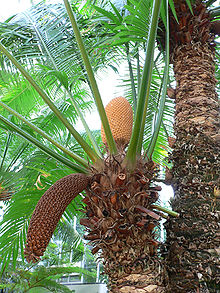
Back سيكاديات Arabic سيكاديات ARZ Saqovniklər Azerbaijani Сагаўнікавыя Byelorussian Цикасоцветни Bulgarian Cycadales CEB Cykasy Czech Cykas-ordenen Danish Palmfarne German Cikasaloj Esperanto
| Cycadales Temporal range:
| |
|---|---|

| |
| Cycas rumphii with old and new male strobili. | |
| Scientific classification | |
| Kingdom: | Plantae |
| Clade: | Tracheophytes |
| Clade: | Spermatophytes |
| Clade: | Gymnospermae |
| Division: | Cycadophyta Bessey 1907: 321.[2] |
| Class: | Cycadopsida Brongn.[1] |
| Order: | Cycadales Pers. ex Bercht. & J. Presl |
| Extant groupings | |
| Synonyms | |
| |

Cycads /ˈsaɪkædz/ are seed plants that typically have a stout and woody (ligneous) trunk with a crown of large, hard, stiff, evergreen and (usually) pinnate leaves. The species are dioecious, that is, individual plants of a species are either male or female. Cycads vary in size from having trunks only a few centimeters to several meters tall. They typically grow very slowly[3] and live very long. Because of their superficial resemblance, they are sometimes mistaken for palms or ferns, but they are not closely related to either group.
Cycads are gymnosperms (naked-seeded), meaning their unfertilized seeds are open to the air to be directly fertilized by pollination, as contrasted with angiosperms, which have enclosed seeds with more complex fertilization arrangements. Cycads have very specialized pollinators, usually a specific species of beetle. Both male and female cycads bear cones (strobili), somewhat similar to conifer cones.
Cycads have been reported to fix nitrogen in association with various cyanobacteria living in the roots (the "coralloid" roots).[4] These photosynthetic bacteria produce a neurotoxin called BMAA that is found in the seeds of cycads. This neurotoxin may enter a human food chain as the cycad seeds may be eaten directly as a source of flour by humans or by wild or feral animals such as bats, and humans may eat these animals. It is hypothesized that this is a source of some neurological diseases in humans.[5][6] Another defence mechanism against herbivores is the accumulation of toxins in seeds and vegetative tissues; through horizontal gene transfer, cycads have acquired a family of genes (fitD) from a microbial organism, most likely a fungus, which gives them the ability to produce an insecticidal toxin.[7]
Cycads all over the world are in decline, with four species on the brink of extinction and seven species having fewer than 100 plants left in the wild.[8]
- ^ Brongniart, A. (1843). Énumération des genres de plantes cultivées au Muséum d'histoire naturelle de Paris.
- ^ Bessey, C.E. (1907). "A synopsis of plant phyla". Nebraska Univ. Stud. 7: 275–373.
- ^ Dehgan, Bijan (1983). "Propagation and Growth of Cycads—A Conservation Strategy". Proceedings of the Florida State Horticultural Society. 96: 137–139 – via Florida Online Journals.
- ^ Rai AN, Soderback E, Bergman B (2000). "Tansley Review No. 116. Cyanobacterium-Plant Symbioses". The New Phytologist. 147 (3): 449–481. doi:10.1046/j.1469-8137.2000.00720.x. JSTOR 2588831. PMID 33862930.
- ^ Holtcamp, W. (2012). "The emerging science of BMAA: do cyanobacteria contribute to neurodegenerative disease?". Environmental Health Perspectives. 120 (3): a110–a116. doi:10.1289/ehp.120-a110. PMC 3295368. PMID 22382274.
- ^ Cox PA, Davis DA, Mash DC, Metcalf JS, Banack SA (2015). "Dietary exposure to an environmental toxin triggers neurofibrillary tangles and amyloid deposits in the brain". Proceedings of the Royal Society B. 283 (1823): 20152397. doi:10.1098/rspb.2015.2397. PMC 4795023. PMID 26791617.
- ^ Liu, Yang; et al. (2022). "The Cycas genome and the early evolution of seed plants". Nature Plants. 8 (4): 389–401. doi:10.1038/s41477-022-01129-7. PMC 9023351. PMID 35437001.
- ^ Davis, Judi (27 June 2018). "Meet Durban's famous cycad family". South Coast Herald. Retrieved 11 September 2022.
© MMXXIII Rich X Search. We shall prevail. All rights reserved. Rich X Search